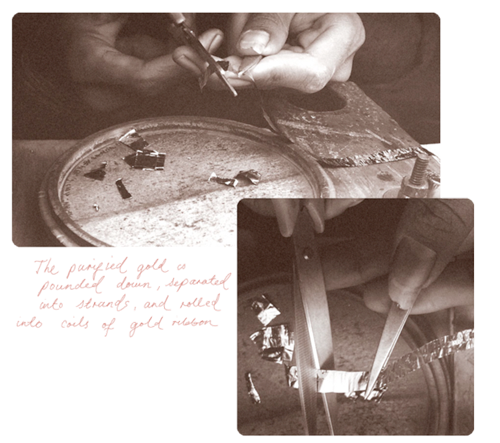Welcome to the AGARO Karkhana, meaning the AGARO workshop in the language of the artisans. Step into a parallel world where the earth’s raw elements are wrought by human hands; a place frozen in time where the Meenakars breathe life into your very own, inimitable piece of jewelry. Let us tell you the story of your hand-crafted piece. And like every good story, it involves travel through time and invites a glimmer of magic.

The story begins far away and long ago, in ancient Iran. This was the land of the Meenakars – artists and masters of the rare enamelling technique: Meenakari. Their craft was highly complex, and profoundly respected. A single piece of jewelry was passed through a chain of expert hands, and the secrets of the process were passed down from generation to generation.
Then, as ever in the world’s most treasured stories, a war broke out. Beauty was destroyed, culture was broken, and what was once loved smoldered. Yet the hopes and dreams of the Meenakars survived with their mystery-shrouded craft.
When the Mughals invaded India, this exquisite artistry was embraced by the Hindu kings – with 9th generation Meenakars still moulding their intricate designs into pure, high carat gold. They still create wonder, beauty and stories, and they still relive the tales of their ancestors through their hand-crafted, ornamented jewelry.

Back to the AGARO Karkhana, the artisans treat the workshop almost as their shrine; they pay their respects to god, and step into a room filled with fresh incense, and just as was customary in the Mughal courts centuries ago, AGARO’s 8th and 9th generation artisans dedicate their lives to the art they love so deeply.

The process begins with the artisan cutting, pounding and firing raw strips of metal to create the ghat, meaning the mounting or base.


Once the ghat is ready, it is passed on for engraving. This is where the Meena, the exquisite enamel design, is forged by the hand of the engraver. Little by little, every minute detail is chiselled out directly into the gold.
Meanwhile, the stonecutter prepares the rough gemstones by carefully carving them into desired shapes.


Meanwhile, the stonecutter prepares the rough gemstones by carefully carving them into the desired shapes.
In our jewelry, we use polkis, a type of uncut, semi-polished diamond - and a natural beauty. Polki diamonds are an heirloom from the Mughal era and emit an old-world, regal allure. The polkis used at the Agaro Karkhana are white and free of any impurities, a clear window into the grandeur of their past.

The engraved jewel then reaches the hands of the Meenakar or Enamellist. Using rare enamels, a combination of natural minerals such as cobalt, copper and hand-ground pigmented glass, the Meenakar decorates the surface of the gold. The fine powdered enamels are even today carefully kept in old medicine containers. The Meenakar fires the powder bit by bit in an ancient kiln, until it fuses with the gold and into the delicately engraved pattern. The jewel has a new birth, as he grinds off the excess enamel and reveals the metal design.


Kundan creation is a process which is extensive in itself: this is the purified, 24 carat gold foil made by firing the gold at white hot temperatures, until any remaining impurities have been scorched away. The purified gold is pounded down, separated into strands, and rolled into coils of gold ribbon, ready to use for Jadhayi or stone setting.


The jewel, now with brilliantly fused enamel, is passed on to the stone setter. Gemstones are set using kundan cut into miniscule strips. Each piece of kundan is meticulously layered to fill the spaces around the gemstone, with each stone taking between 200-300 strips of gold.


The final touches are in place: the edges and bumps are smoothed off, the polish and finesse is added. The imperfections are perfect and as unique as our DNA.




